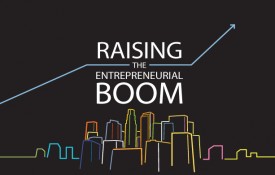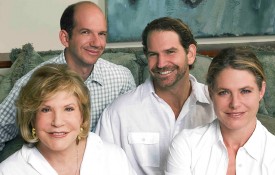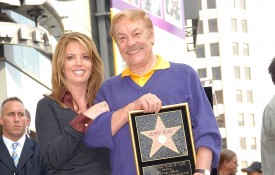On New Year’s Day 1931, Albert Einstein arrived in Pasadena to take up a winter appointment as a Visiting Fellow at the California Institute of Technology. What drew him here were the theories of a Caltech professor, mathematical physicist Richard Chase Tolman, and a local astronomer Edwin Hubble. The two believed – in contrast to Einstein – that our universe was expanding. That intrigued Einstein.
The idea that Einstein, the greatest mind of the 20th century, came to Los Angeles not only to teach, but also to learn from other prominent thinkers, proved a harbinger of great things to come for the region. For the next 50 years the region’s university and college network grew and took full advantage of LA’s hospitable climate and its innovative and creative spirit to attract hundreds of thousands of new pioneers to their campuses, drawn by a simple idea – regardless of your background, this was a land of opportunity.
By the 1950s and 1960s, LA’s economy was on the move. Its workforce was building jet planes, rocket engines, and space capsules that propelled man to the moon, and then brought him home safely. In the fall of ’69, a professor at the University of California, Los Angeles kicked off the Internet by activating the first node that sent a message from the campus. By the 1970s and 1980s LA was flush with research and development funding, and its economic cornerstones were aerospace, manufacturing, and entertainment.
Today LA still has a vibrant and dynamic economy. Since 2010, some of the region’s most globally competitive industries linked to software, media, entertainment, and healthcare have secured more than $2.6 billion in new venture capital funding.
Yet the region’s unemployment numbers remain stubbornly high – 8.7 percent for the City of LA and 7.9 percent for LA County. San Francisco, Irvine, Silicon Valley, and San Diego all enjoy rates below 5 percent even though they have similar high cost of living challenges.
LA’s challenge is not fully unique. The world’s skilled talent is more mobile than ever; they are choosing global cities that are investing in quality of life initiatives that help foster an environment in which collective talent can turn ideas into business opportunities and jobs. Just as Caltech discovered in 1931, talent attracts talent and new discoveries.
Washington, D.C., San Francisco, Boston, and San Jose are great examples of region’s embracing this idea. In the last decade these cities have increased their population’s level of 25-to-34 year olds with at least a four-year college degree to almost half.
LA has the world’s largest higher education system with 112 college and university campuses which produce more Ph.D.s and graduate degrees than any in America, and they are home to the world’s greatest research institutes and concentration of Nobel laureates, MacArthur fellows, and members of the National Academies.
The Los Angeles metropolitan region has also been successful, attracting 664,000 new 25-to-34 year olds with a bachelors degree in 2012 (a 30.4 percent increase since 2000). Yet LA seems to have two challenges — a turnstile economy and a growing population of 25 year olds and older – 48 percent in the city – who only possesses a high school degree or less.
Recent research from the Manhattan Institute showed that since 2000, the LA region has become California’s leader in net domestic migration to states like Arizona, Texas, and Nevada. Two thirds of those leaving were in our region’s workforce. In 2010 the LA Mayor’s Council on Innovation and Industry found that since 2008, 54 percent of UCLA’s engineering graduates have chosen to relocate from the region for a job. Further research shows that LA is graduating more engineers than Northern California by the astonishing ratio of three to one – but the vast majority of those graduates have chosen to relocate upon graduation.
The question becomes – what are we overlooking in our efforts to attract, retain, and develop a more educated and skilled workforce?
The LA region has the characteristics of a world-class economy. It is an international gateway, home to the largest container ports in the U.S. and the world’s busiest origin and destination airport. It has the nation’s largest manufacturing base, the world’s leading entertainment companies, and a substantial base of small- and medium-sized businesses. It provides access to the world’s most diverse consumer markets and is home to a large share of educated people working in our most globally competitive industries – technology, entertainment, biotechnology, and advanced manufacturing.
LA has the world’s largest higher education system with 112 college and university campuses which produce more Ph.D.s and graduate degrees than any in America, and they are home to the world’s greatest research institutes and concentration of Nobel laureates, MacArthur fellows, and members of the National Academies. LA’s network of five Cal State campuses now educate 110,000 students; they will celebrate their role in graduating the Cal State system’s 3 millionth student this year.
This collective intelligence alone should make LA our nation’s biggest job generator.
How can we turn this around? The first place I would look is higher education and high tech.
LA’s college and university campuses and high tech companies have become our new “Anchor Tenants,” a term Stanford University sociologist Woody Powell uses to describe institutions that provide economic character and culture to a region. This network supports hundreds of thousands of jobs, research and education opportunities, and they commit incredible amounts of human and financial resources to LA’s communities.
The Los Angeles County Economic Development Corporation just reported that the region currently supports 763,600 high tech jobs across a broad spectrum of industries. These are jobs that, on average, pay 70 percent more than other industries. Each new high tech job helps to create four more quality jobs for accountants, administrative assistants, and human resource professionals, to name a few.
Combining this talent, resources and bandwidth would serve as the catalyst for economic and job growth starting with bio-tech, tech companies, entertainment and media firms, and light manufacturing.
The business community is in a prime position to leverage and partner with this network to help accelerate LA’s transition from industrial-based to information-based. This past year a joint effort between the business community, the city of Los Angeles, USC, and LA’s Cal State schools successfully secured a federal designation giving our region preferential access to $1.3B in government funding for local aerospace and advanced manufacturing industries.
LA city and county government could do more through targeted economic development initiatives that provide better land management practices for industrial land and housing and more responsive building development services.
The good news is LA is building the foundation for future growth and have momentum on their side. Within the last three years, LA has invested more than $4B in their international airport and $1.2B in the port, and LA Metro is in the process of spending $16B on new transit lines throughout the region with another $20B dedicated throughout the next 30 years. Local government is expediting the development of 25 new hotels and is ready to invest millions of dollars into its convention center located next to LA Live in downtown.
Albert Einstein once quipped that “the power of compound interest is the most powerful force in the universe.” By making the right investment moves in LA now, we can all share in the benefits to come.














































